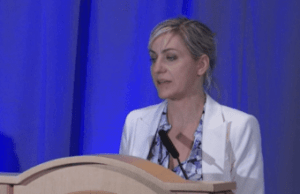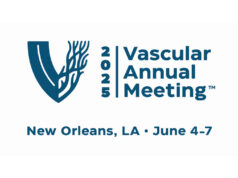
This advertorial is sponsored by ACHL.
For Anahita Dua, MBChB, the stark realities and complexities of peripheral arterial disease (PAD) patients undergoing endovascular treatment for chronic limb-threatening ischemia (CLTI) coalesce into one important truth: the necessity of entering the operating room armed with “a plan A, a plan B and a plan C.”
Readiness is key, according to the assistant professor of surgery at Massachusetts General Hospital and Harvard Medical School in Boston, if the ultimate goal of restoring appropriate flow to the foot is going to be obtained.
Dua was speaking as part of an expert group of faculty drawn from across vascular surgery, interventional cardiology and interventional radiology to discuss the latest advances and key decision-making strategies used when considering intervention for four key vascular conditions: CLTI, venous thromboembolism (VTE) encompassing acute iliofemoral deep vein thrombosis (DVT) and acute pulmonary embolism (PE), and post-thrombotic syndrome (PTS).
In a series of Interactive CME Touchpoints, Dua and other leading expert clinicians cover the identification of candidates for interventional procedures, the latest clinical trial data on available and emerging devices, as well as case-based applications for practice, for each disease process.
When it comes to CLTI, she is clear on what constitutes the key to interventional success: “Procedural planning is probably the most important thing when you’re approaching a patient from an endovascular standpoint,” Dua tells viewers of the 45-minute activity during which she and Mitchell Weinberg, MD, chair of the Department of Cardiology at Staten Island University Hospital in New York, discuss the latest updates in approaches to interventions for CLTI.

“You can only know your enemy if you’ve looked at the procedural planning prior, and you know what you have available to you on the shelf in order to approach these patients. Obviously in the case of endovascular treatment, no matter how good you may be, if you don’t have the tools that you need, and you don’t have them readily available for you, [then] you can’t achieve the goals that you want. So, in procedural planning the key is two-step: One, you need to look at the previous imaging of the patient, and two, look at the most recent imaging, and compare it to the previous imaging to determine where exactly your target is and how you intend to get there.”
Alternative plans gather importance given interventionists can confront numerous challenging scenarios, Dua adds. That might be failure to navigate a lesion, or achieving breakthrough, but the balloon won’t track. Over the course of the CLTI Touchpoint activity, Dua and Weinberg cover risk assessment of CLTI, examples of above-the-knee interventions, the challenges faced when treating PAD below-the-knee, along with the latest clinical trial and safety data, and case-based applications for practice.
Management of acute iliofemoral DVT
Kush Desai, MD, associate professor of radiology, surgery and medicine at Northwestern University Feinberg School of Medicine in Chicago, notes the fertile grounds interventionists currently occupy in the treatment of DVT. In the acute iliofemoral DVT activity in the Touchpoint series, he outlines how despite advancements in the medical treatment of DVT, nearly half of all patients go on to develop post-thrombotic syndrome (PTS).
Endovascular interventions have shown promise, Desai tells viewers. “This is a really exciting time in DVT management and DVT intervention because we now have prospective, high-quality evidence that is giving us a clearer idea of when we should intervene on patients,” he says. “DVT is a really common problem, and there are patients that have more severe forms of DVT—those that expand up into the iliac vein. In those patients, we have the possibility through endovascular interventional methods of actually improving their quality of life, in the short-term improving some discomfort, and, most importantly, reducing the severity of post-thrombotic syndrome that can result if they were treated with just anticoagulation alone.”
The 30-minute Touchpoint includes video commentary on key clinical trial data and patient selection for endovascular interventions to reduce the risk of PTS. Meanwhile, Desai also addresses the impact and severity of PTS, and the role of interventions in improving patient quality of life. He covers topics such as the PTS burden, specific clinical trials that examine the use of catheter-directed interventional methods for improving outcomes after DVT, and a “How I Do It” case.
Closing in on PTS

Meanwhile, Desai introduces Erin Murphy, MD, director of the Venous and Lymphatic Institute at Sanger Heart and Vascular, part of Atrium Health, in Charlotte, North Carolina, at the juncture of PTS.
While discussing the latest updates in the condition, the expert pair in venous disease review the newer dedicated venous stents now available, as well as limitations with conservative therapies in another 30-minute Touchpoint activity.
Making use of images, charts and graphs, Desai and Murphy offer their expert perspectives on the treatment of PTS, the benefits of venous stenting, and the best follow-up approach in patients post-stenting. They delve into risk assessment of PTS, non-procedural versus procedural care, the latest clinical trial data on the four dedicated venous stents that have been developed, and case-based applications for practice.
“The incidence of DVT in the U.S. is about 1 million cases per year, or just under,” Murphy points out, “so the occurrence of PTS is also correspondingly high. Further, the prevalence is very high because often the patients are not treated. They are managed with compression, so there’s more and more patients over time that have this [condition]. Unfortunately for them, quality of life mirrors that for other severe, underlying medical conditions, including COPD [chronic obstructive pulmonary disease], heart failure, diabetes with complications, and these are often younger patients in those groups.”
Addressing a question from Desai on whether she saw any gaps in the treatment of PTS, viewers hear from Murphy on knowledge deficits she sees among many physicians who encounter these patients—and the patients themselves. “There is a gap in education for referring providers,” she explains. “I think we’ve seen a greater increase in referring in the past five years or so, but I think a lot of physicians still don’t know that we can treat these patients.”
A lot of technical training needs to be done, she tells Desai. “I think we both still treat a lot of stent complications as more providers start doing these procedures without formal education, so I think there’s a need for training. From a technical standpoint, I think we still need treatment options for the inflow. Some patients are not candidates for stenting because of poor inflow or have stent failures because of poor inflow, and we don’t really have good options once these stents occlude, which is why it’s important to treat them correctly and to select patients correctly.”
Crucial decision-making in acute PE
In addition, Adrian Messerli, MD, an interventional cardiologist and a professor of medicine at the University of Kentucky in Lexington, navigates viewers through updates on guidelines and trials dotting the current interventional therapeutic PE landscape. In this Touchpoint, Messerli draws particular attention to “the underuse” of catheter-directed thrombolysis. “A common question is whether or not catheter-directed therapies are underused for treatment in acute PE,” he explains.
“I think level-1 evidence is still lacking, so this is a somewhat contentious question. However, when you look at surrogate endpoints, namely right ventricle to left ventricle ratio reduction, and recognizing the benefits for patients in terms of in-hospital mortality and recurrent PE, I think there’s a strong argument that these therapies should be used more liberally.
“In addition, for those who have been using these therapies for a while, anecdotally these patients typically feel better quicker, and I think that’s an important issue as well.”
Ensure you are prepared to optimally manage your patients with CLTI, VTE, or post-thrombotic syndrome by accessing these engaging CME activities today. Visit www.achlcme.org/interventional-approaches-svs and learn about tackling complications from this group of expert faculty. Supported by an educational grant from Boston Scientific.












